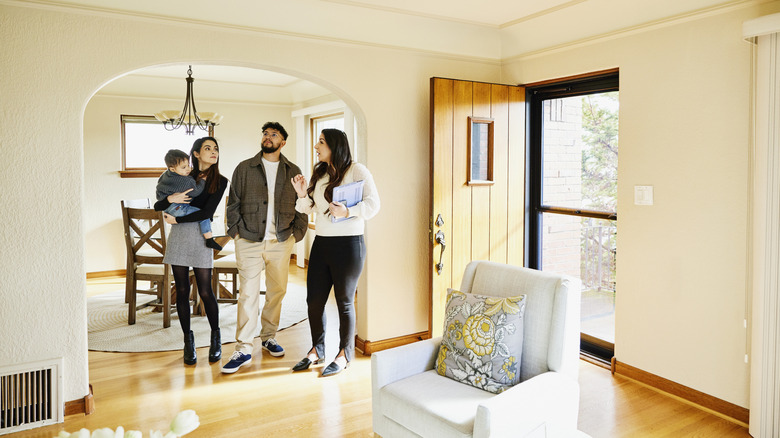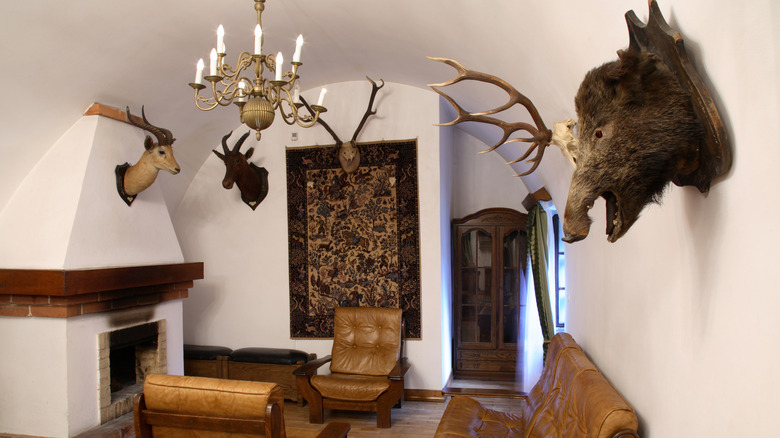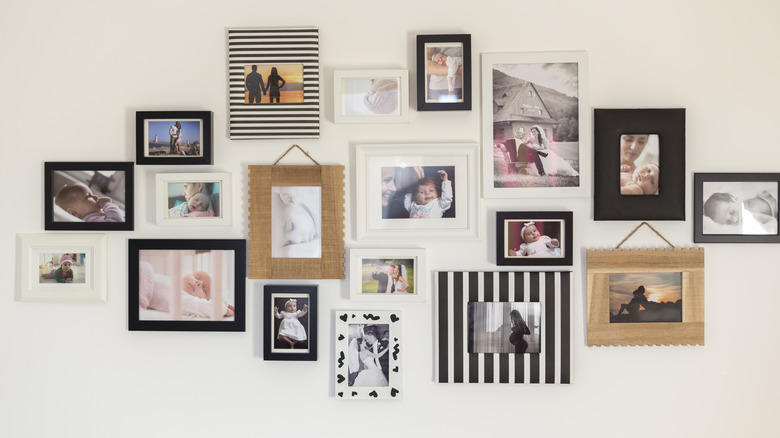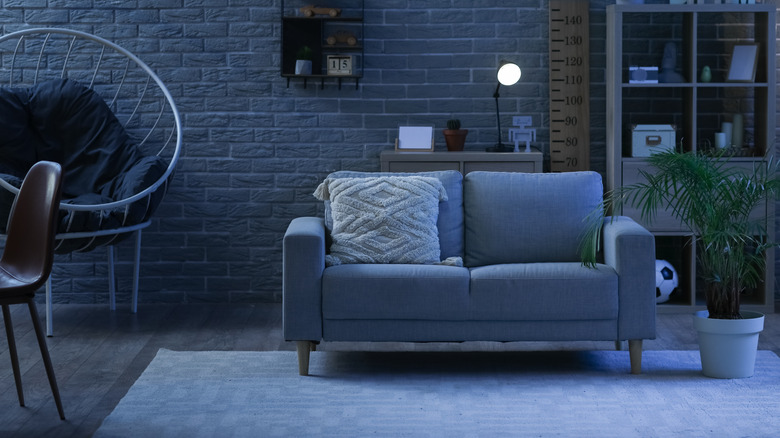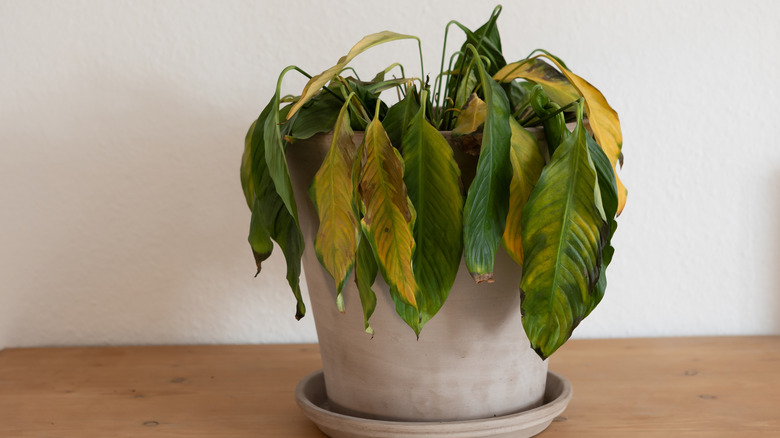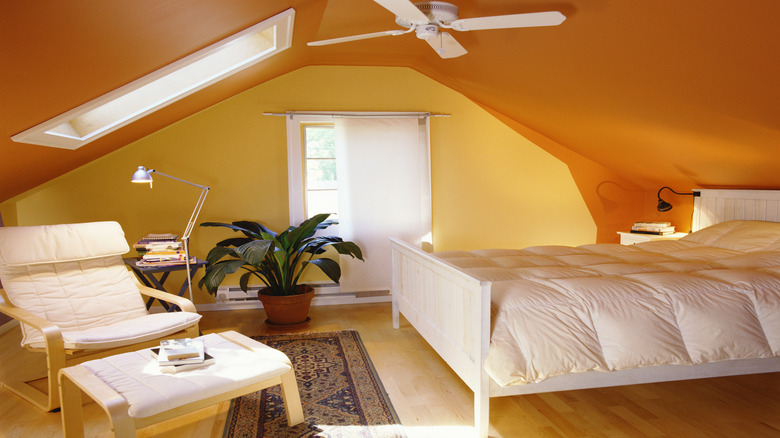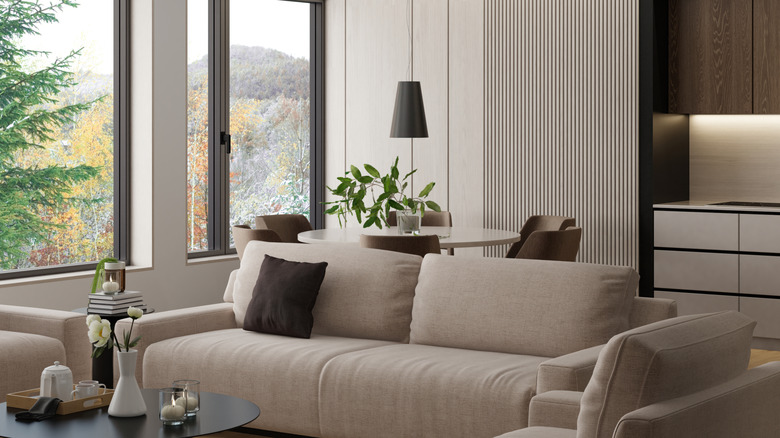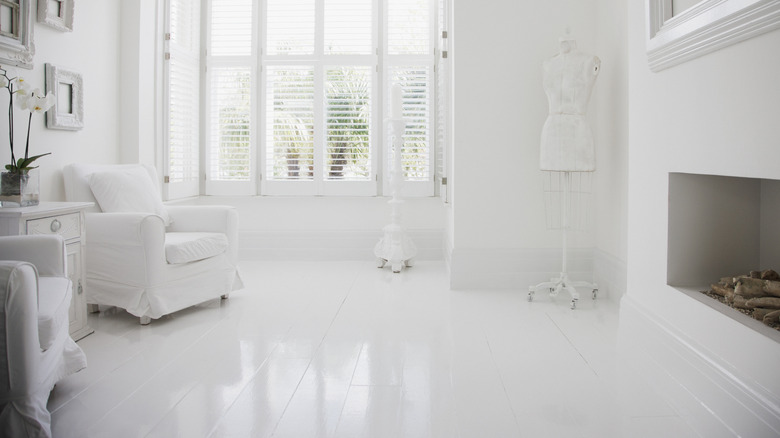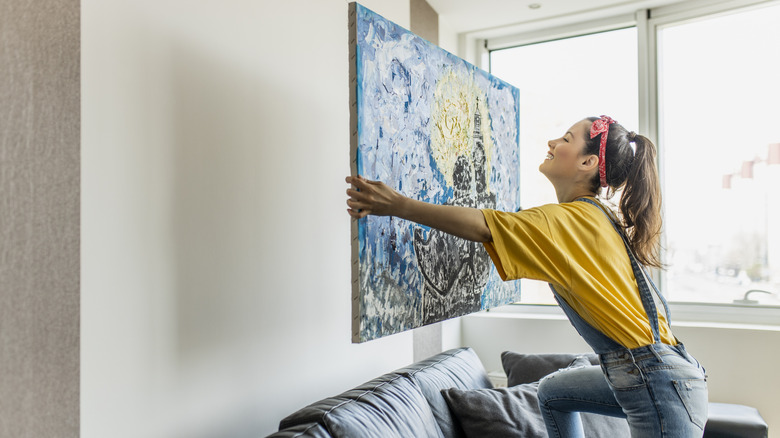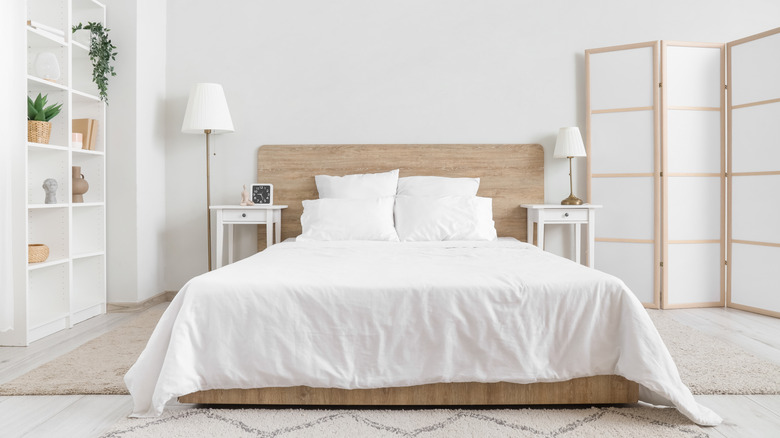Home Decor Choices That Are Making It Harder For You To Sell Your House
We may receive a commission on purchases made from links.
Sometimes your decor choices can be your own worst enemy when trying to sell your home, simply because of how deeply personal they are. This becomes tricky when you put your house on the market since you're expected to make your home seem as neutral as possible in order to appeal to the widest net of potential buyers. But without realizing it, your decor might be turning some of them away. Luckily, by putting away a few overly-personal styling choices, you'll make it easier for buyers to picture themselves living in your home.
Real estate agents, house stagers, and even celebrity stylists agree that while you might not have the budget to splash out and change major features of your home — like the flooring or a severely outdated bathroom — you can make your house feel more appealing with a few strategic decor swaps. If you are about to put your home on the market, or it has been sitting there for a while with no bites, take a quick walk-through with the suggestions below in mind. In some cases, you may be able to significantly increase your chances of a sale with just a few hundred bucks — or a few hours of elbow grease.
Personalized craft projects are better put away
DIY home decor has become more and more popular over the years, but when you are trying to sell your house, it's typically best to tuck your favorite craft-like projects away. Creations like clothes racks made from ladders, walls covered in cork boards, or even wallpapered cabinet doors can add value to your everyday life — however, a buyer might not agree. These items are just a touch too quaint and personal for mass-market appeal.
Instead, stick to tried-and-true store-bought classics when getting ready for open houses and showings. Swap the clothing ladder racks for more streamlined options, like this Laiensia Double Rods Garment Rack, to keep things a touch more chic. Take the corkboards off the walls and give them a fresh coat of paint to cover the evidence — same with the cabinets. Your home decor should be as neutral and professional-looking as possible when you're trying to sell.
Consider your location before displaying any hunting trophies
If you live in a place where many buyers are likely to be outdoorsy — like somewhere in Colorado or central Texas — having hunting trophies on display may not be a major issue during your showings. That said, there is always the possibility that your home could be known as the "moose house" by a disgruntled buyer. To avoid dampening your chances at a big sale, there are a few things to consider when it comes to trophy mounts.
The first is, of course, the location of your home and the hunting culture of the local area. Next, consider the aesthetic of your house. Does it have the wooden-paneled walls or large stone fireplace of a hunting lodge? Then the trophies might enhance the overall vibe. Finally, consider the size and number of the trophy mounts on display in relation to the overall size of the room. If you have a large one in a small space, it could put buyers off because of how crowded things look. The same could be said for any room with lower ceilings — the imposing frame might shrink things even more. In this case, it's best to tuck them away in climate-controlled storage while you are trying to sell.
A few family photos are fine, but be sure they're arranged artfully
When trying to sell your house, it's best to depersonalize your space as much as possible. So often, realtors will advise clients to remove all their family photos before listing day. This way, potential buyers will be able to imagine their own family in the home instead of just seeing your smiling faces beaming down at them.
Yet, other staging experts think that, as long as things are arranged artfully, having family photos up shouldn't be an issue at all. "With a family photo wall, it may be a good thing if it's done really well, so people can imagine their own family there," art expert David Kassel told The New York Times. "Our experience is that [buyers] have a really hard time making these design decisions and can't fathom how to arrange pictures." For example, if you have a large open wall in the living room, creating a symmetrical grid of large black and white photos can show buyers how to potentially decorate the space. Work with your listing agent for the best results for the space that you have. At the end of the day, less is usually more when it comes to family photos.
The lone lamp in the living room isn't giving the space enough light
Good lighting is important when it comes to trying to sell a house. If you aren't a fan of the "big light" and don't have a ceiling fixture, that's typically fine for an evening showing — just as long as you make up for it with additional light sources. The brighter a space, the more welcoming and larger it can appear. Having just one lamp in the corner might work for your everyday life, but it's never going to convince a buyer that your living room doesn't feel like a dungeon.
For success, you should first draw on as much natural light as you can. Keep the windows clean and the curtains pulled back. Replace heavy drapery with sheer options. This White Sheer Curtain from OWENIE will solve the issue of maintaining a touch of privacy while still letting in plenty of light. Adding more than one statement lamp can also make the living room brighter and more inviting. The Ambimall Modern Floor Lamp should do the trick. Before a showing, be sure to test the best placement for each lamp to see if any of the room is lost to shadow patches. Adjust their location accordingly, but pay special attention to wires so they don't end up a tripping hazard or looking unsightly.
Overloading your house with plants won't work unless they are healthy
Having greenery in the house is a great decor idea while you are trying to sell, but if you don't think you will be able to stay on top of their upkeep, then it's best to skip the option altogether. While having fresh cut flowers on the kitchen table or a monstera in the bathroom can be alluring, dead flowers of a browning plant undo all of this thoughtfulness. The dying plants will just put people off.
Adding plastic plants isn't the perfect happy medium, either. They can collect dust and, in some cases, make your home seem a bit too much like a 1990s office building than a dynamic personal property. Instead, if you'd like to use greenery as decor while selling your home, stick with plants that are easy to care for. There are houseplants anyone can keep alive, like aloe vera, a snake plant, and ZZ plants. If you prefer to go the cut flowers route, change the water every three days or so. Also trim back the bottom of the stems each time you change the water to make sure the cuts are still getting what they need. At around the 10 to 14-day mark, it's time to swap things for a fresh bouquet.
Bold paint colors could scare buyers away
Neutral decor is best when trying to sell a house. While you live there, you might have enjoyed a dreamsicle orange for your bedroom or a bold maroon for the den — however, the mass market of potential buyers is more likely to be put off by these choices. All they will see during the showing are the dollar signs needed to repaint the property once its theirs. To save them this step, and potentially get a better initial offer on your home because they don't think it's a fixer upper, it's best to repaint the interior of your house before listing. Luckily, there are some painting tips HGTV stars swear by to get you started.
According to a 2024 user survey by Fixr, up to 81% of respondents indicated that they prefer warm neutrals for interior walls, with 69% stating that they would also be alright with shades of white. In general, calm colors should always be favored over bold options when trying to sell. This is backed by the survey's data, as only 3% of those surveyed indicated their interest in deep/rich tones. Just by the numbers, trying to appeal to just 3% of your potential buyer pool is quite the risky game. Instead, it's better just to repaint.
Patterned wallpaper is hard to appeal to the masses
Like bold paint colors, wallpaper is another very individualistic decor choice. While you might love the funky, intricate pattern that covers your bedroom, buyers could find it overwhelming or just plain ugly. Because of this, there are two main things to keep in mind when decorating with wallpaper: the type of wallpaper you use and the pattern or color you select.
If you love the look of wall coverings, be sure to use a peel-and-stick option when first installing it. Peel-and-stick is easy to install for even the newest of DIYers and, luckily, also easy to take off without causing too much damage to the wall underneath. This makes it a great decor trick for renters, but also for homeowners who need to depersonalize their space when prepping for a sale. The second thing is to consider more neutral wallpaper patterns from the get-go. This way, you don't need to remove them when it's time to sell. If you know you'll be moving soon, never pick a pattern with more than three colors, with two being the sweet spot. The intricacy of the pattern should also be minimal: think pinstripes, a simple geometric design, or soft floral imagery. For instance, give the Erfoni Herringbone Peel and Stick Wallpaper a try.
Over-furnished rooms tend to make a space feel too restrictive
You might love to lounge on your massive sectional couch or kick back with your partner in matching La-Z-Boy recliners, but these decor choices could be making it harder for you to sell your house. Pieces that are too big for a space, or take up too much of the room and restrict movement, can put buyers off. This is because they will see the room as small. If buyers have to squeeze around your furniture, they will likely have a hard time imagining their own fitting into the space.
To fix things, start with a walk-through. Can you freely move through the home without running into anything or having to maneuver too much? If you are too familiar with the layout, have a friend who lives offsite do the walk-through with you for a new perspective. Next, even if you can move around, consider the overall scale of the room. Does it have high ceilings? If so, you are more likely to get away with bigger pieces of furniture. This is because the extra space up top can trick the eye into thinking the room is bigger than it is. If the ceilings are low — around 9 feet or below — you need to swap things for smaller furniture. You might also need to remove it completely while you are trying to sell. Otherwise, it will be too cramped.
Too much white gives your home a hospital-like feel
Neutral colors are good, but if your home has too much stark white, it might start to look and feel more like a hospital. That is, if you have a white couch, white carpet, and white curtains, it'll scream "sterile" rather than "blank slate." Luckily, converting your space into something a touch more welcoming is as easy as swapping out a few textiles to add soft accented colors. You don't even have to repaint!
To start, think of adding new cases to your white throw pillows. These Corduroy Decorative Throw Pillow Covers from MIULEE are machine-washable and come in many different colors. Select the option that best complements any secondary colors you might already have in the space. If you only have white, beiges, browns, and grays, you can still add that nice pop of color without being overwhelming. You can also produce a similar impact with a new throw blanket or curtains — anything to soften and warm up the starkness of the white. Designers like Leanne Ford have also found great success adding warmth to an all-white interior with texture instead of color. Think of things like thick, wooly throw blankets, wooden tables, or even metal accents through lamps or light fixtures.
Controversial artwork is best left for personal enjoyment
Having a few fun pieces of art on the wall is a great idea, even when you're trying to sell a house. Arranging frames with care can give potential buyers a good perspective on how they might decorate the house once it's theirs. However, if the content of the work is suggestive or controversial, it can dampen your chances of a sale. You don't want your property to be known as "that house." Avoid displaying paintings depicting nudity, violence, or anything overtly political. It's best to place these pieces in climate controlled storage during the selling process.
Experts instead recommend swapping these prints for more neutral options, such as a scene of a local landscape, something abstract, or even a still life of everyday items. They don't have to be boring, like something you'd see in a dentist's office. However, they should be mild enough that the only thought a buyer might have is, "That's nice," and not, "Can you believe what they had hanging on their wall?" A good example are these Claude Monet Giclée Art Prints from EVOLE or this Framed Canvas Wall Art from OIQArtOIQ that comes in many different sizes, so you can choose based on the scale of your wall.
Clashing aesthetics might feel confusing for buyers
Having a cohesive design theme throughout your house is essential to putting its best foot forward. If you have a kitchen that looks more modern farmhouse, but a mid-century modern living room and minimalist bedroom, your home might feel confusing and disjointed to buyers. Instead, ensuring each room of your house has a similar style can create cohesion throughout your home.
It doesn't make sense to purchase a new bed frame, new lamps, and even a new couch just to create continuity during the staging process if you don't plan to use them once you move. Instead, if you find that you have a more eclectic style, consider working with a staging company to rent pieces for when you have open houses. These experts can set up your home with rental items to maximize its look and feel.
